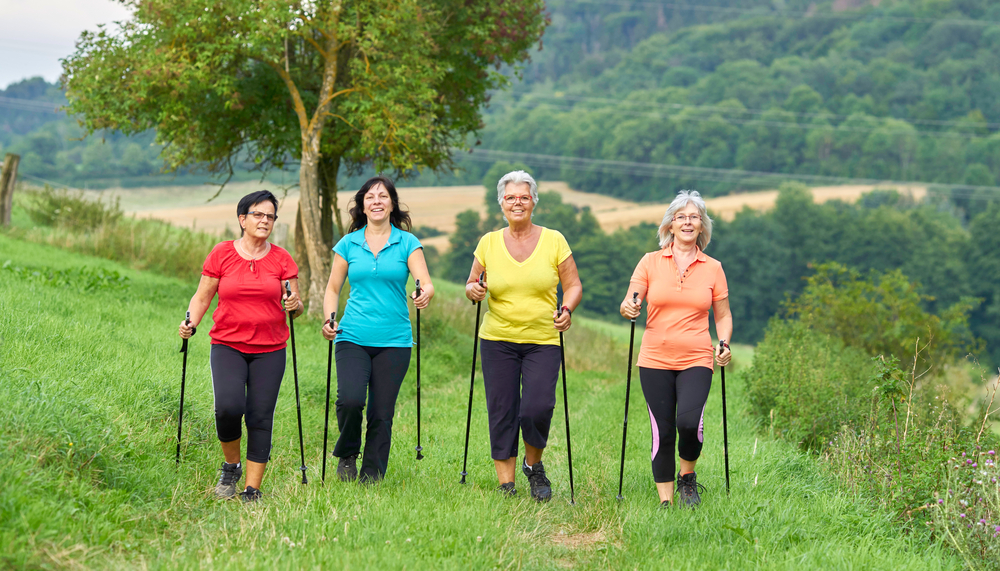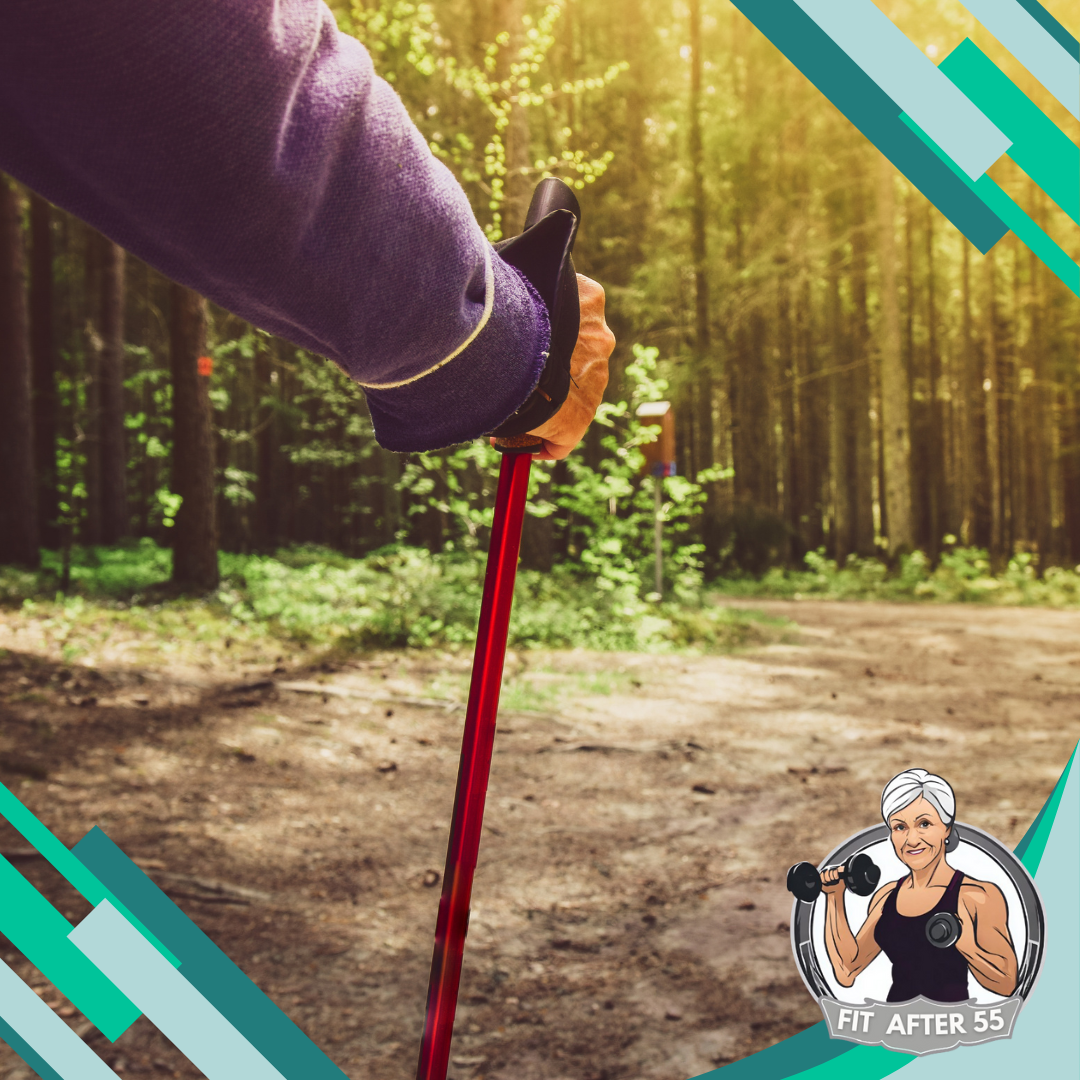Nordic walking compared to traditional exercise regimens offers a comprehensive full-body workout by engaging both the upper and lower body muscles simultaneously. Yet it’s a statement that some may not believe right away without adequate proof.
Now, as someone who values staying active and exploring various forms of exercise, I’ve always appreciated the multitude of traditional workout routines available. From jogging to weightlifting, each offers its own set of health benefits and unique experiences. However, recently I thought of sharing something truly special: Nordic walking. With its growing popularity and intrigued by its distinct approach to fitness, I decided to share what I had learned about it and delve deeper into telling others about what sets Nordic walking apart from the rest.
In this article, we’ll explore the origins, techniques, benefits, and comparisons of Nordic walking to traditional exercise regimens. So if you’re curious about this increasingly popular activity or looking to spice up your fitness routine, join me as we uncover the wonders of Nordic walking.
How Does Nordic Walking Compare to Traditional Exercise Regimens?
Nordic walking, a full-body exercise that originated in Finland as a summer training regimen for cross-country skiers, has now gained popularity worldwide as a stand-alone fitness activity. But how does Nordic walking compare to traditional exercise? I wondered if it was any better than just going for a walk. I found some interesting facts about my new found fitness plan.

Unlike traditional walking, Nordic walking includes the use of specially designed walking poles similar to ski poles, which engage the upper body and allow for a more intensive workout.
This form of exercise capitalizes on the natural movement of walking and adds a rhythmic, low-impact element. This can be beneficial for people of all ages and fitness levels.
Comparing Nordic walking to other forms of exercise highlights its unique benefits.
It’s an accessible outdoor activity that combines cardiovascular exercise with muscle strengthening and flexibility.
The added benefit of the walking poles not only aids in balancing but also in intensifying the workout. Nordic walking uses up to 90% of the body’s muscles, which is more than what’s typically used in standard walking or jogging.
This increased muscle engagement can lead to more calories burned and improved endurance over time.
Additionally, for individuals with joint pain or arthritis, Nordic walking can be a good alternative, as the poles help redistribute weight and reduce strain on the joints. This helps increase the safety, too.

Key Takeaways
- Nordic walking engages more muscles than regular walking for a comprehensive workout.
- It is accessible to various fitness levels and can be less straining on joints.
- Walking poles intensify the workout, leading to higher calorie burn and improved endurance.
Concept and Origin of Nordic Walking
The development of Nordic Walking is rooted in a Finnish exercise method, offering a full-body workout. This practice extends beyond a simple walk in the park, incorporating specific walking poles for enhanced benefits.

Definition of Nordic Walking
Nordic Walking is a fitness activity that amplifies the natural walking experience.
You use walking poles similar to ski poles, which engage your upper body muscles and provide support.
This form of exercise capitalizes on the action of walking, with the poles adding an upper body element to what is traditionally a lower body workout.
The technique is designed to improve cardiovascular fitness and muscle strength, exemplifying a total-body version of walking.
Historical Evolution
The roots of Nordic Walking trace back to the early cross-country ski training in Finland. It was formally introduced in 1966 by a physical education teacher named Leena Jääskeläinen.
She implemented the concept of “walking with ski poles” for her students’ exercise routines.
Over time, it evolved into the structured fitness regimen known today, promoted for its health benefits and as a distinct sport.
Noteworthy in their role to formalize the activity, Finnish sports institutions played a critical part in this evolution, making the practice accessible to both non-athletes and athletes alike.
Comparative Analysis of Exercise Forms: Nordic Walking Compare to Traditional Exercise
In assessing various exercise forms, you’ll find that each has unique impacts on your health. Below, Nordic walking is compared to conventional walking and resistance training, highlighting differences in cardiovascular impact, musculoskeletal benefits, and calorie expenditure.

Cardiovascular Impact
A study outlines that Nordic walking can lower resting heart rate and blood pressure, and improve exercise capacity as well as maximal oxygen consumption (Health benefits of Nordic walking: a systematic review).
This form of exercise, using poles to engage the upper body, can bolster heart health more efficiently than conventional walking alone.
Musculoskeletal Benefits
While all walking is good for maintaining muscle health, Nordic walking engages more muscle groups compared to conventional walking.
The addition of poles helps in working the arms, shoulders, and upper back, thereby providing a more comprehensive musculoskeletal workout.
The resistance provided by the poles means that Nordic walking can also be comparable to band-based resistance exercise in improving functional fitness and dynamic balance (Effects of Nordic walking compared to conventional walking and band-based resistance exercise on fitness in older adults).
Calorie Expenditure
When it comes to burning calories, Nordic walking surpasses standard walking due to its full-body engagement.
The use of poles in Nordic walking increases energy expenditure; therefore, you burn more calories than with conventional walking, aligning it closer to the calorie burn associated with resistance training.
The precise difference in calorie burn will depend on intensity, duration, and individual effort.
Equipment and Technique
To engage in Nordic walking, you need specially designed walking poles and a grasp of the proper technique to make the activity effective and enjoyable.

Nordic Walking Poles
You require Nordic walking poles, which differ from standard trekking or hiking poles.
These poles come in fixed or adjustable lengths and usually feature ergonomic grips with wrist straps for comfort and stability.
To select the right pole size for your height, your elbow should be at a 90-degree angle when holding the poles with the tips touching the ground.
For durability and flexibility, look for poles made from materials like carbon fiber or aluminum.
Proper Technique and Posture and the effect of Nordic Walking Compare to Traditional Exercise
Your Nordic walking technique is paramount for the exercise’s efficacy.
- Grip: Hold the pole with a relaxed grip and use the wrist straps to avoid holding too tightly.
- Arm Movement: Swing your arms naturally from the shoulder and plant the pole at an angle behind you.
- Posture: Maintain an upright stance, looking forward with shoulders relaxed, ensuring efficient breathing and stride.
- Stride: Your stride should be smooth and natural. When you step forward, the opposite arm and pole should move in conjunction with your leg movement.
By integrating the use of poles and focusing on your technique, Nordic walking turns into a full-body workout that utilizes various muscle groups comprehensively.
Accessibility and Popularity: Nordic Walking Compare to Traditional Exercise
Nordic walking, compared to other forms of exercise, is recognized for its ease of uptake and the growing number of practitioners across the globe.

Global Reach and Adoption
Nordic walking has expanded beyond its Scandinavian origins to become a popular form of exercise in numerous countries around the world.
This can be seen in the increasing number of Nordic walking groups and clubs that cater to enthusiasts of all ages.
For instance, events and organized walks have been instrumental in promoting Nordic walking in various regions, enhancing its global presence.
Ease of Learning and Accessibility
You can quickly pick up Nordic walking with the assistance of poles that are designed to work your upper body and improve balance.
The sport is low-impact and suitable for individuals at varying levels of fitness, including those who may be limited by joint issues.
Equipment accessibility is good, with poles available at diverse price points, contributing to the sport’s popularity among a wide demographic.
Health and Fitness Benefits
Nordic Walking stands out for its dual focus on improving physical fitness and enhancing mental health. You’ll find that the combination of aerobic exercise with muscle strengthening and balance enhancement offers a comprehensive workout.

Enhancement of Physical Fitness
- Cardiovascular Endurance: By engaging the upper body through the use of poles, Nordic walking increases heart rate and circulation, providing a better overall workout than traditional walking.
- Muscle Strength & Flexibility: It targets over 90% of your body’s muscles, contributing to increases in muscle strength, endurance, and flexibility.
- Weight Management: This form of exercise also aids in managing body composition by contributing to reductions in fat mass and waist circumference.
Mental Health and Well-being
- Mood Improvement: Regular participation in Nordic walking can lead to decreases in depression, anxiety, and chronic pain, helping uplift your mood.
- Stress Reduction: The rhythmic motion and outdoor setting can be meditative, fostering relaxation and reducing stress levels.
- Enhanced Quality of Life: It contributes to a higher quality of life, marked by improvements in well-being and increased core strength, which plays a role in daily function and balance.
Risks and Considerations
When you embrace Nordic walking as your exercise of choice, it is essential to consider the risks and practice caution to prevent injury and ascertain whether it’s appropriate for your health status.
Injury Potential
Nordic walking is typically a low-impact activity that is gentler on the joints compared to high-impact exercises. However, even with its low impact nature, you can still encounter injury if not performed correctly. Key risks include:
- Overuse injuries: Repetitive motion may lead to strain on your shoulders or wrists, especially if pole usage is incorrect.
- Muscle soreness: It’s possible to experience soreness when you begin Nordic walking due to the engagement of upper body muscles not commonly used in regular walking.
- Tripping or falling: Incorrect use of poles or walking on uneven terrain can increase the risk of tripping or falling.

Suitability for Different Populations
Who is Nordic Walking best suited for? Nordic walking is great exercise for a wide range of individuals, but there are certain populations that should approach it with extra care:
- Older adults: It can improve balance and functional fitness, but older walkers should start slow and possibly consult a healthcare provider (Effects of Nordic Walking Compared to Conventional Walking).
- People with joint issues: The exercise is often beneficial for those with arthritis, as it produces less load on the joints and may reduce pain (Nordic Walking: Benefits, Affects on Arthritis Pain, and How-To).
- Individuals with stability concerns: While Nordic walking can enhance safety for those with balance or gait instability, careful technique and perhaps a guided introduction to the exercise are recommended.
Nordic Walking in Competitive Sports
Many are surprised to find that Nordic Walking is becoming increasingly recognized in the competitive sports arena. As an enhancement of traditional walking, it incorporates the use of specialized poles to engage the upper body muscles, thus providing a more holistic workout.
You will find that competitive Nordic Walking is governed by organizations such as the International Nordic Walking Federation (INWA), which hosts events and championships.
When you participate in Nordic Walking competitions, the focus is on speed and technique.
The technique is critical; judges may monitor athletes to ensure the correct form is maintained throughout the race. This includes the proper use of poles and the coordination of pole-plant and stride.
Competitions vary from sprints to marathons, with different categories for age and skill level:
- Sprint races: Typically 100 meters to 5 kilometers
- Long distance: 10 kilometers to full marathons (42 kilometers)
Your equipment will play a role in your performance. Nordic Walking poles are made of lightweight materials such as carbon fiber, and selecting the right pole height is crucial for competitive walking. Shoes should also provide good support and flexibility.
Here’s a quick breakdown of competitive categories:
| Category | Distance | Equipment |
|---|---|---|
| Sprint | 100m-5km | Carbon poles |
| Middle distance | 5km-10km | Lightweight poles |
| Marathon | 42km | Custom-fit poles |
Adaptations and Variations of Nordic Walking
Nordic Walking can be adapted and varied to suit your fitness level and goals. As you progress, you may encounter different techniques and equipment that can enhance your workout experience.

Equipment Variations:
- Poles: Choose between fixed-length and adjustable poles. Adjustable poles cater to different exercises and terrain. Meanwhile, fixed-length poles are optimal for consistent walking conditions.
- Paw Styles: Rubber paws for poles vary in shape for different surfaces. Opt for angled paws on asphalt and rounded paws for trails.
Technique Variations:
- Stride and Pace: Adjust your stride length and walking pace for a more intense workout or a comfortable walk.
- Pole Angles: Experiment with the pole’s angle of insertion into the ground to engage different muscle groups.
Terrain Adaptations:
- Flat Ground: Offers a steady workout, improving endurance.
- Inclines: Challenge your cardiovascular system and leg muscles more intensively.
- Mixed Terrain: Engages stabilizing muscles due to the changing surfaces.
Intensity Levels:
- Leisurely Walks: For relaxation and light exercise, maintain a gentle pace with moderate pole use.
- Fitness Walking: Increase your pace and actively press the poles for a full-body workout that burns more calories.
Nordic Walking Compared to Traditional Exercise: A Final Reflection
Nordic walking has emerged as a compelling addition to the realm of fitness, offering a holistic approach to exercise that engages both the upper and lower body muscles. Throughout this exploration, we’ve traced its origins, examined its benefits, and compared it to traditional exercise regimens.

While traditional exercises remain integral to maintaining a healthy lifestyle, there’s an undeniable allure and utility to Nordic walking. Its accessibility, full-body engagement, and low-impact nature make it a standout choice for individuals of all ages and fitness levels.
As we bid farewell, I encourage you to share your thoughts and experiences with Nordic walking. Your feedback is invaluable as we continue to discover and embrace the diverse avenues of physical activity. Thank you for joining me on this journey towards improved health and wellness.
Frequently Asked Questions
Nordic walking is a full-body exercise that has unique benefits and considerations when compared to other forms of exercise. Explore these FAQs to understand its impacts and how it might fit into your fitness routine.
What are the health benefits associated with Nordic walking?
Nordic walking provides a better overall workout by engaging more than 90% of your body’s muscles. It’s known to enhance cardiovascular health, increase calorie burn, and may be easier on the joints compared to traditional jogging or running.
How does Nordic walking impact muscle usage compared to regular walking?
Compared to ordinary walking, Nordic walking increases core strength and utilizes muscles in the upper body, turning a simple walk into a comprehensive full-body workout.
What are the potential disadvantages of engaging in Nordic walking?
One of the potential disadvantages is the initial cost of purchasing specialized Nordic walking poles. Also, mastering the technique might present a learning curve for newcomers to the sport. However, when I learned more about how Nordic Walking Compare to Traditional Exercise, especially with regard to our slightly older bodies, I found these poles to be an advantage! Indeed, they help keep us more balanced and stable as we walk, especially in less flat terrain.
Can Nordic walking serve as an effective substitute for high-intensity interval training (HIIT)?
While Nordic walking is an excellent cardio workout, it may not reach the intensity levels found in HIIT sessions. However, it can be a lower impact alternative that still offers significant fitness benefits.
In terms of fitness gains, how does Nordic walking compare with traditional trekking?
Nordic walking can provide a comparable full-body workout to traditional trekking. It activates up to 90% of the body’s muscles, similar to the demands of trekking. It is also typically more accessible and requires less difficult terrain.
